
What is the ACT? The ACT, short for the American College Test, is a standardized test offered by ACT, Inc. for undergraduate college admissions. In this post, we will cover everything you need to know about the ACT test, including when, where, and how to take the test; how the ACT is scored and what is a good ACT score; how hard is the ACT; how to send ACT scores; tips for studying for the exam; and much more. Read on for a complete guide on the ACT, and use the Table of Contents below to jump to any topic you’re interested in.

The ACT is comprised of five sections: English, Math, Reading, Science, and Writing. The English, Math, Reading, and Science sections are required sections with multiple choice questions. The Writing section is optional and involves writing one response to a prompt in 40 minutes.
Section | # of questions | Time | Time per question |
|---|---|---|---|
English | 75 | 45 minutes | 36 seconds |
Math | 60 | 60 minutes | 60 seconds |
Reading | 40 | 35 minutes | 52.5 seconds |
Science | 40 | 35 minutes | 52.5 seconds |
Writing (optional) | 1 | 40 minutes | 40 minutes |
Total (without Writing) | 215 | 175 minutes | 49 seconds |
Let’s go over each section in detail.
The ACT English section tests you on your English conventions, writing, and reading abilities that you learn in middle and high school (grades 6-12) in the United States. The ACT English section contains 75 questions and you have 45 minutes to complete them, which gives you about 36 seconds per question. But don’t fret – ACT English questions are centered on passages, so you will be doing these questions in five batches and have 9 minutes to complete each passage batch.
ACT English question type | % of test | # of questions |
|---|---|---|
Conventions of standard English | 52 - 55% | 39 - 41 |
Production of writing | 29 - 32% | 22 - 24 |
Knowledge of language | 15 - 17% | 11 - 13 |
Total | 100% | 75 |
There are three types of ACT English questions you will see on the exam:
Conventions of standard English (52-55% of the ACT English section)
Conventions of standard English questions test you on correct punctuation, conventions of usage, sentence structure, and general English grammar. You will need to be able to apply an understanding of sentence structure and formation to be able to improve the passage, recognize punctuation mistakes and correct them, and recognize ‘common problems with standard English usage’ in a passage. In all of these questions, you’re acting like the editor of your friend’s essay, making sure they get the details right and follow English grammar rules correctly.
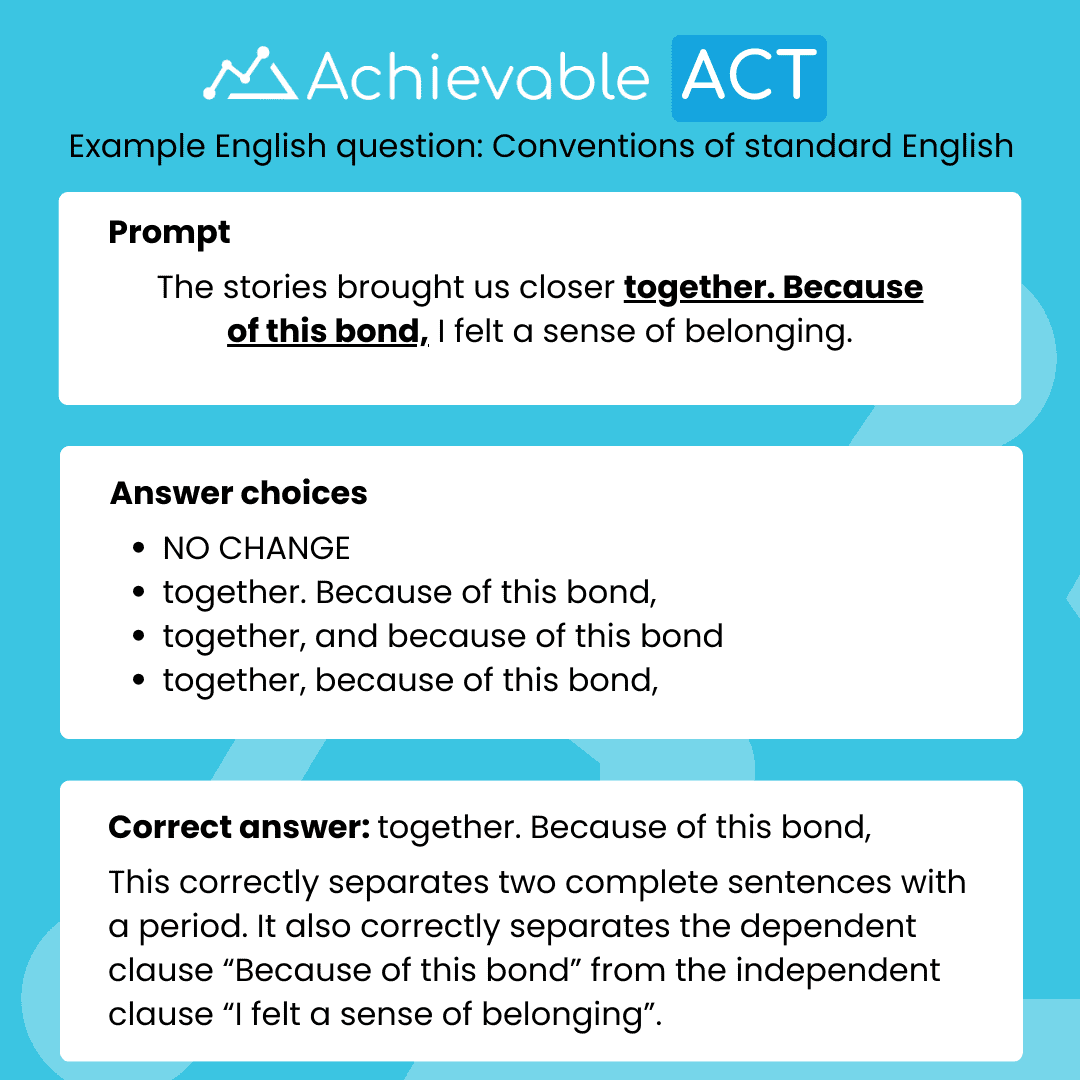
Conventions of standard English example question
Production of writing (29-32% of the ACT English section)
Production of writing questions test your ability to decipher information and identify the author’s purpose in passages. You will need to be able to identify purposes of parts of texts, determine whether the text has achieved that purpose, and evaluate whether the text is reflective of the material mentioned. Think of this like a school assignment where you’re being asked to evaluate an argument and determine whether it is valid and supported by the evidence.
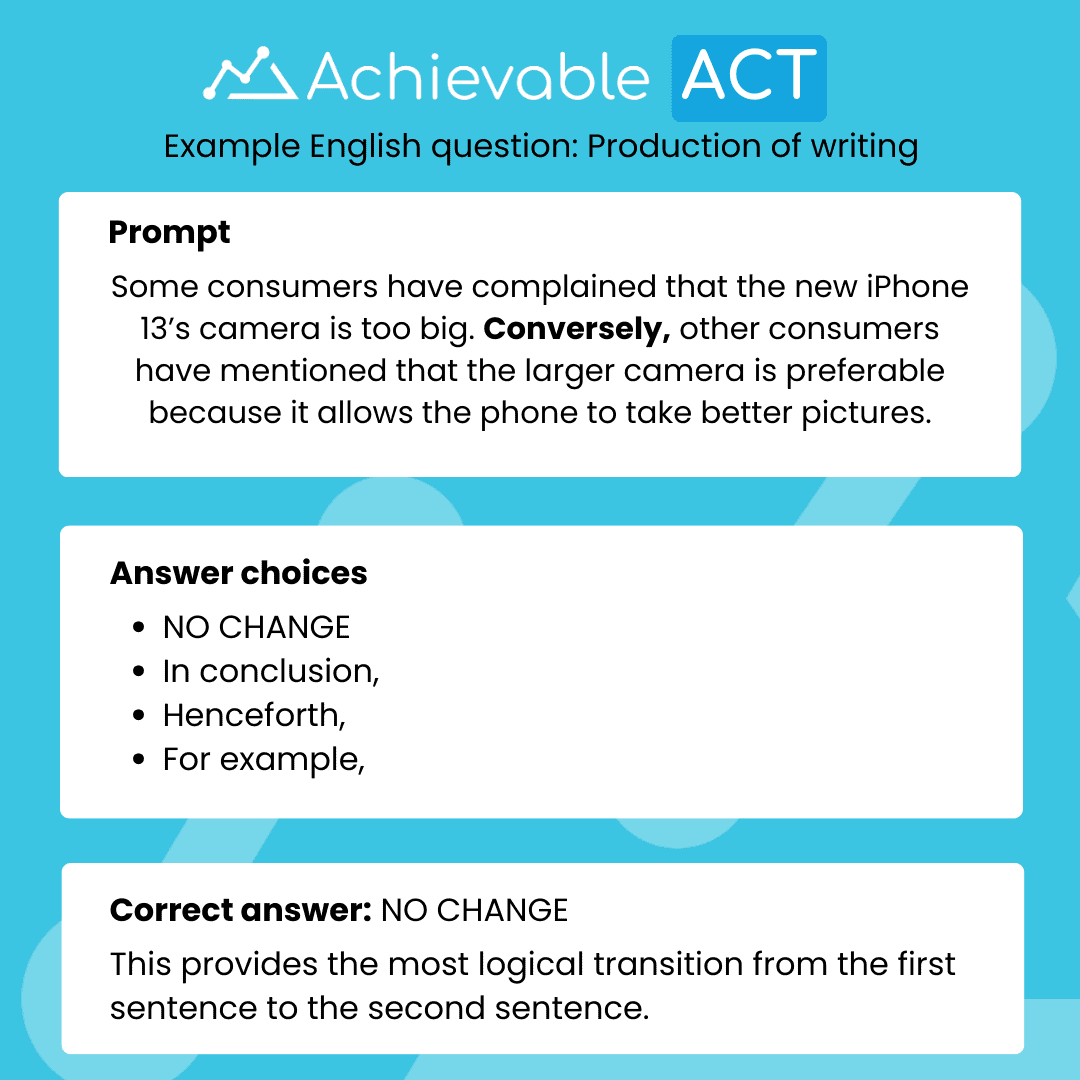
Production of writing example question
Knowledge of language (15-17% of the ACT English section)
Knowledge of language questions ask you to evaluate and improve a sentence or phrase’s style, tone, and meaning. This section is focused on vocabulary, conciseness, and rhetorical style. These questions focus on word choice (including splitting hairs between similar-but-slightly-different vocabulary words), and maintaining a consistent style and tone within the sentence or related to the passage.

Knowledge of language example question
How to beat the ACT English section
The key to mastering the ACT English section is to ensure that you have all of the English grammar rules down pat. The ACT English has an interesting twist in that many questions have “NO CHANGE” as one of the answers. You will need to know the rules in order to determine whether the original answer is correct or if it’s one of the others.
It’s also important to make sure you’re understanding the writing style, tone, and argument of the passage you’re reviewing. The context of each passage is important, even when a question is asking about a specific sentence or phrase.
Make sure to approach questions carefully as well. Some questions might not have an underlined portion and instead ask you about the passage or a part of the passage as a whole. Other questions might flip the prompt and ask you or the alternative that is worst instead of best.
The ACT Math section tests you on the mathematics that you learn in middle and high school (grades 6-12) in the United States, including types of number systems, algebra, functions, geometry, and statistics & probability. The ACT Math section contains 60 questions and you have 60 minutes to complete them, which gives you 1 minute per question.
ACT Math problems are typically self contained, but there are some groups of 2-4 problems that reference the same chart or graph. Many of the ACT Math questions are word problems, so identifying what math the question is actually asking for is crucial. The questions increase in difficulty from question 1 to question 60, so it is important to focus on the easier questions first.
ACT Math question type | % of test | # of questions |
|---|---|---|
Preparing for higher math | 57 - 60% | 34 - 36 |
Number and Quantity | 7 - 10% | 4 - 6 |
Algebra | 12 - 15% | 7 - 9 |
Functions | 12 - 15% | 7 - 9 |
Geometry | 12 - 15% | 7 - 9 |
Statistics & Probability | 8 - 12% | 5 - 7 |
Integrating essential skills | 40 - 43% | 24 - 26 |
Modeling | Present throughout | N/A |
Total | 100% | 60 |
Now let’s break down the types of questions you’ll see on the ACT Math section:
Preparing for Higher Math (57-60% of the ACT Math section)
The Preparing for Higher Math section covers basically all of the mathematics that most students are expected to learn by the end of high school. This question type has five subcategories:
Number and Quantity (7-10% of the ACT Math section)
Number and Quantity questions ask you to show your understanding of number rules and number systems. You will need to understand how to interpret different mathematical expressions, handle exponent and other problems, and deal with vectors and matrices.
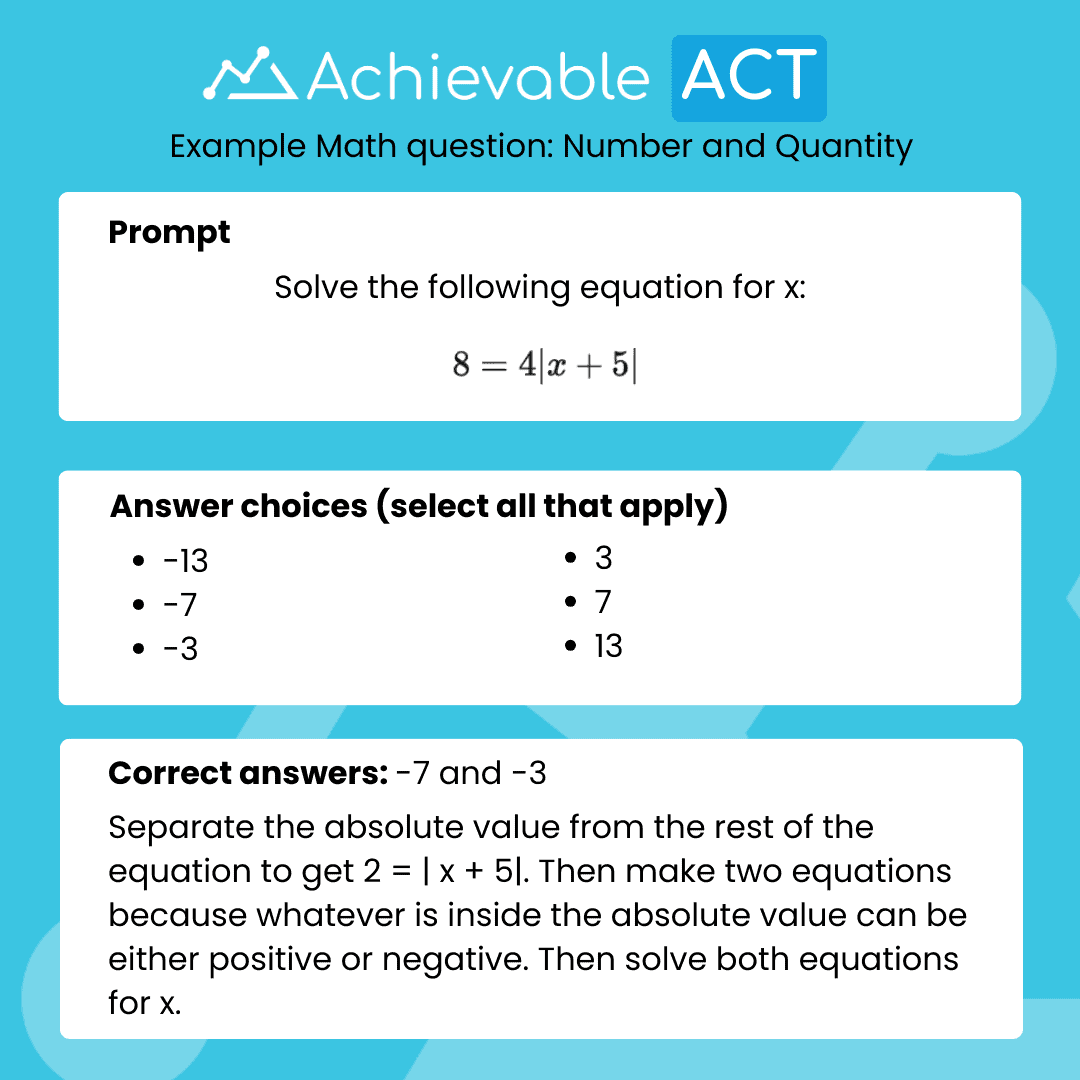
Number and Quantity example question
Algebra (12-15% of the ACT Math section)
Algebra I and II are both covered extensively in the ACT. These questions will ask you to solve or graph different types of expressions and equations. The types of equations you’ll see include linear, polynomial, exponential, radical, and systems of equations.
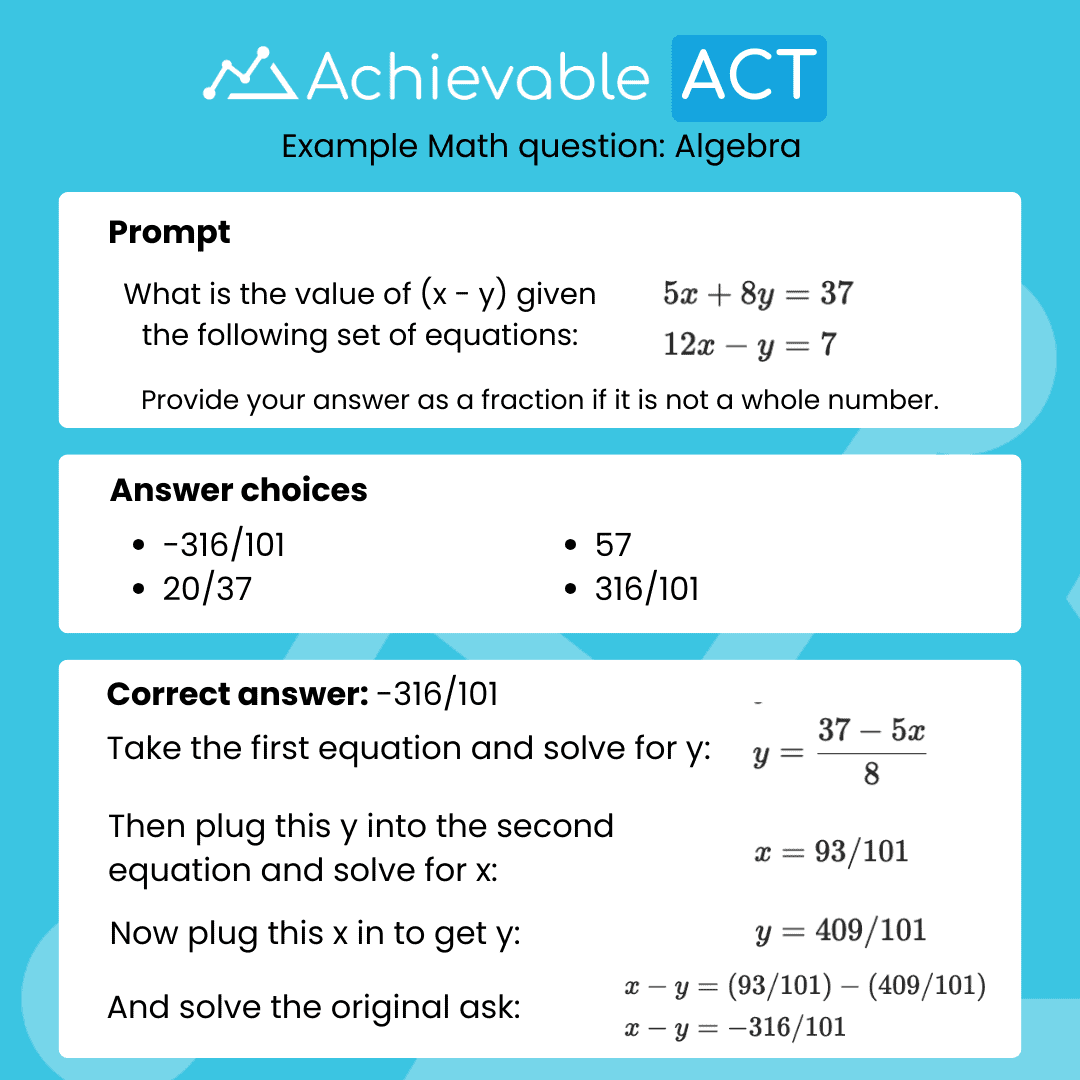
Functions (12-15% of the ACT Math section)
Functions questions will ask you to show that you can use functions (naturally), from the basic to the complex. You will need to be able to use most common function types including linear, radial, polynomial, exponential, and logarithmic functions. This section also contains a fair amount of graphs.
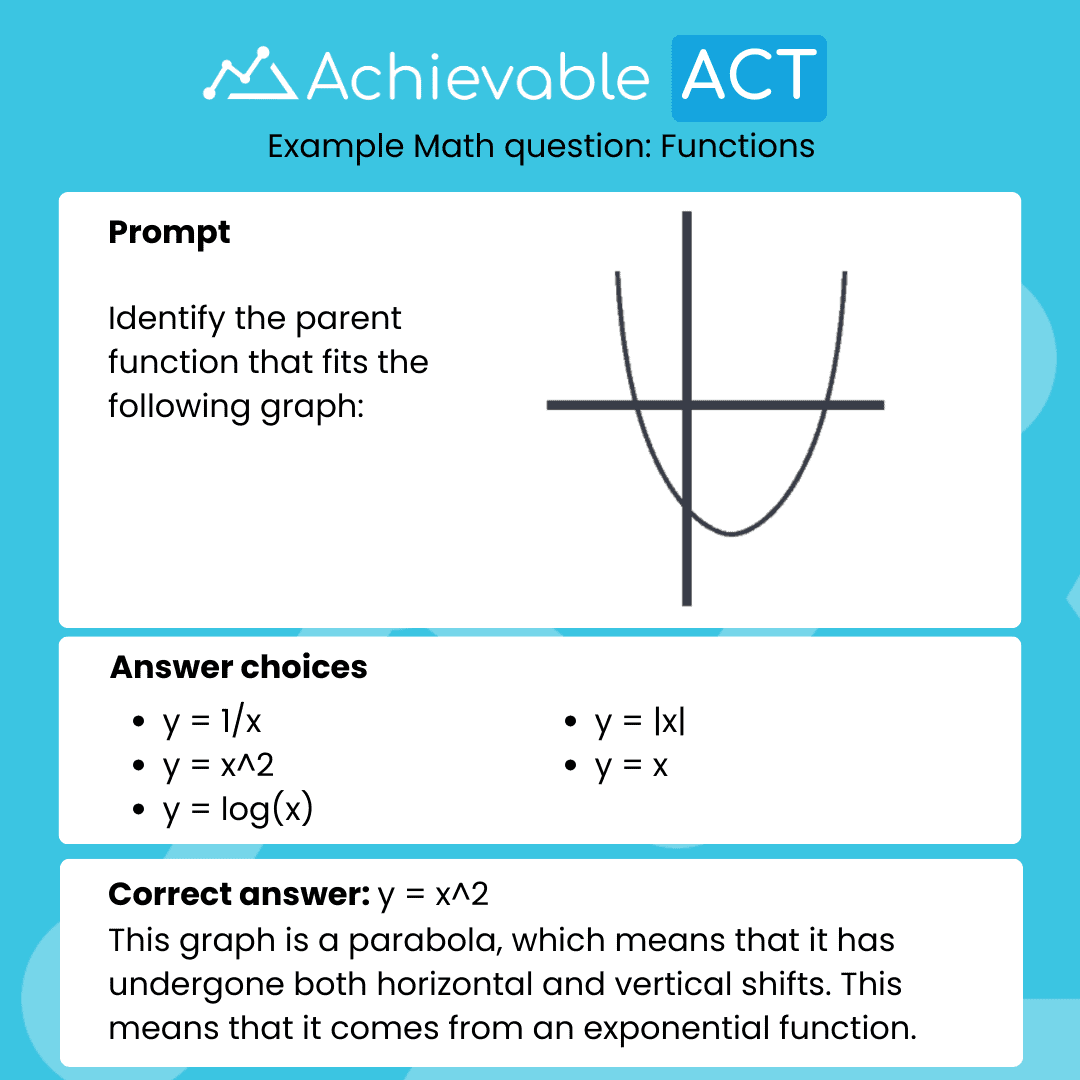
Geometry (12-15% of the ACT Math section)
Geometry, which is the mathematical properties of 2D and 3D shapes, is also tested heavily on the ACT Math. You will need to understand the relationships between sides and angles of different shapes and how to calculate area, perimeter, and volume of these shapes. You will often be asked to use existing information to determine missing values. Trigonometry does appear in harder questions, but it is not common.
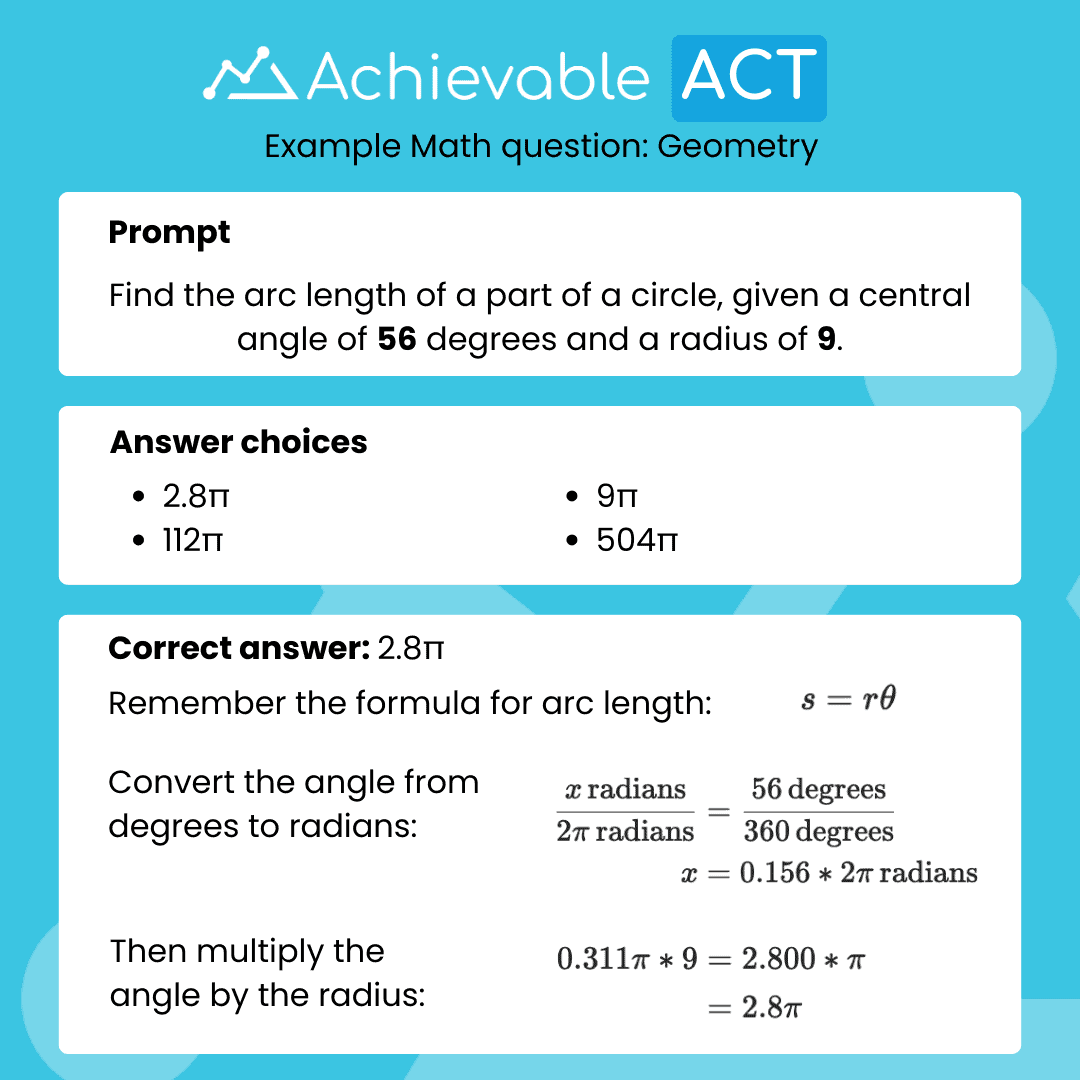
Statistics & Probability (8-12% of the ACT Math section)
Statistics & probability questions ask you to interpret data sets and understand the relationships between the data variables. You will also be asked to calculate probabilities and review data collection methods.
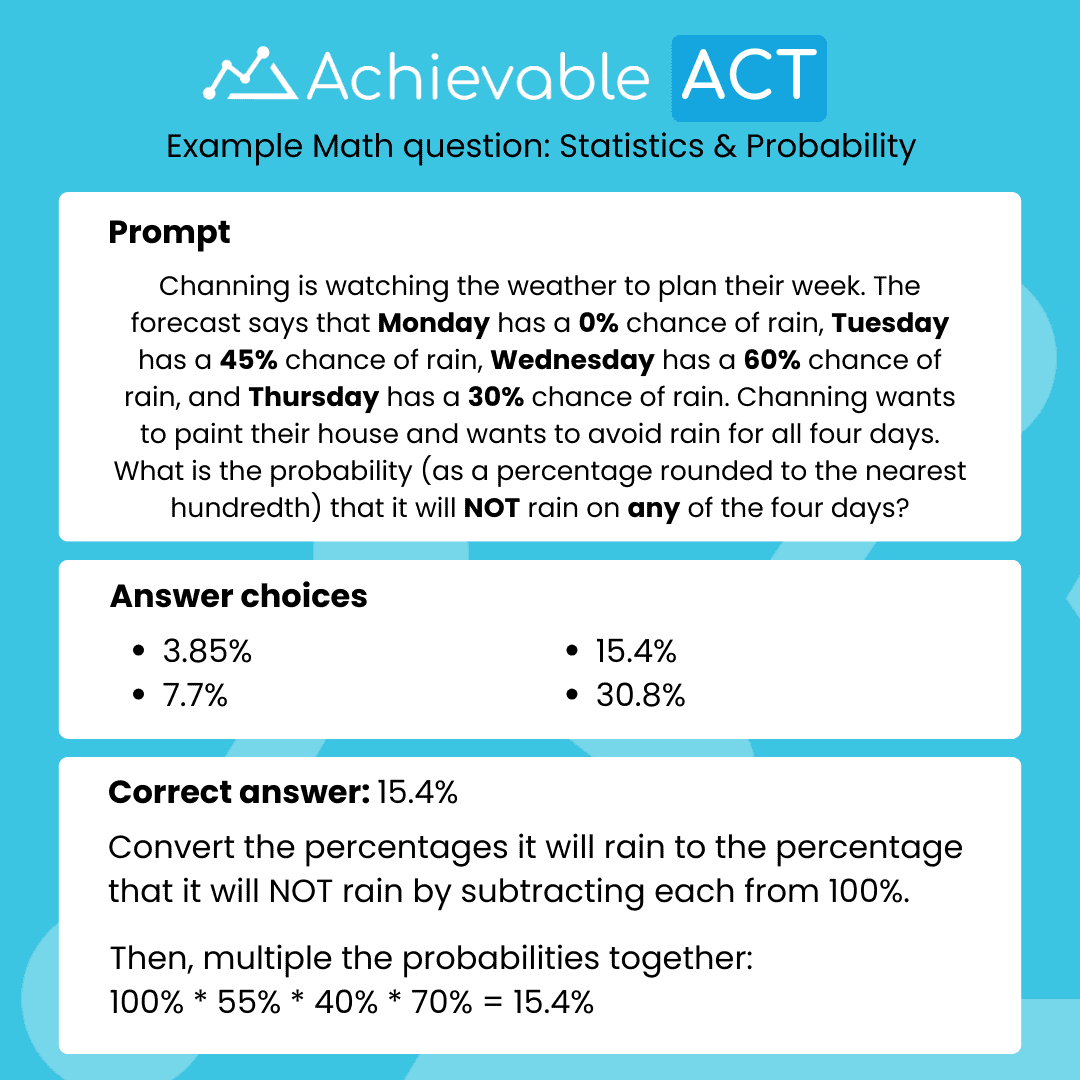
Statistics & Probability example question
As you can see, the types of problems you’ll see within Preparing for Higher Math are pretty evenly distributed. You’ll want to make sure you brush up on all the math you’ve learned since middle school to stay on top of the ACT Math section.
Integrating Essential Skills (40-43% of the ACT Math section)
Integrating Essential Skills questions test your ability to solve complex problems by utilizing the things you’ve learned in high school math. These problems are intended to be tricky, requiring you to combine concepts from multiple Preparing for Higher Math subcategories. You will need to be strong in relationships between objects, rates and percentages, calculating geometry values like area and volume in complicated situations, calculating averages in complicated situations, and expressing numbers in various ways.
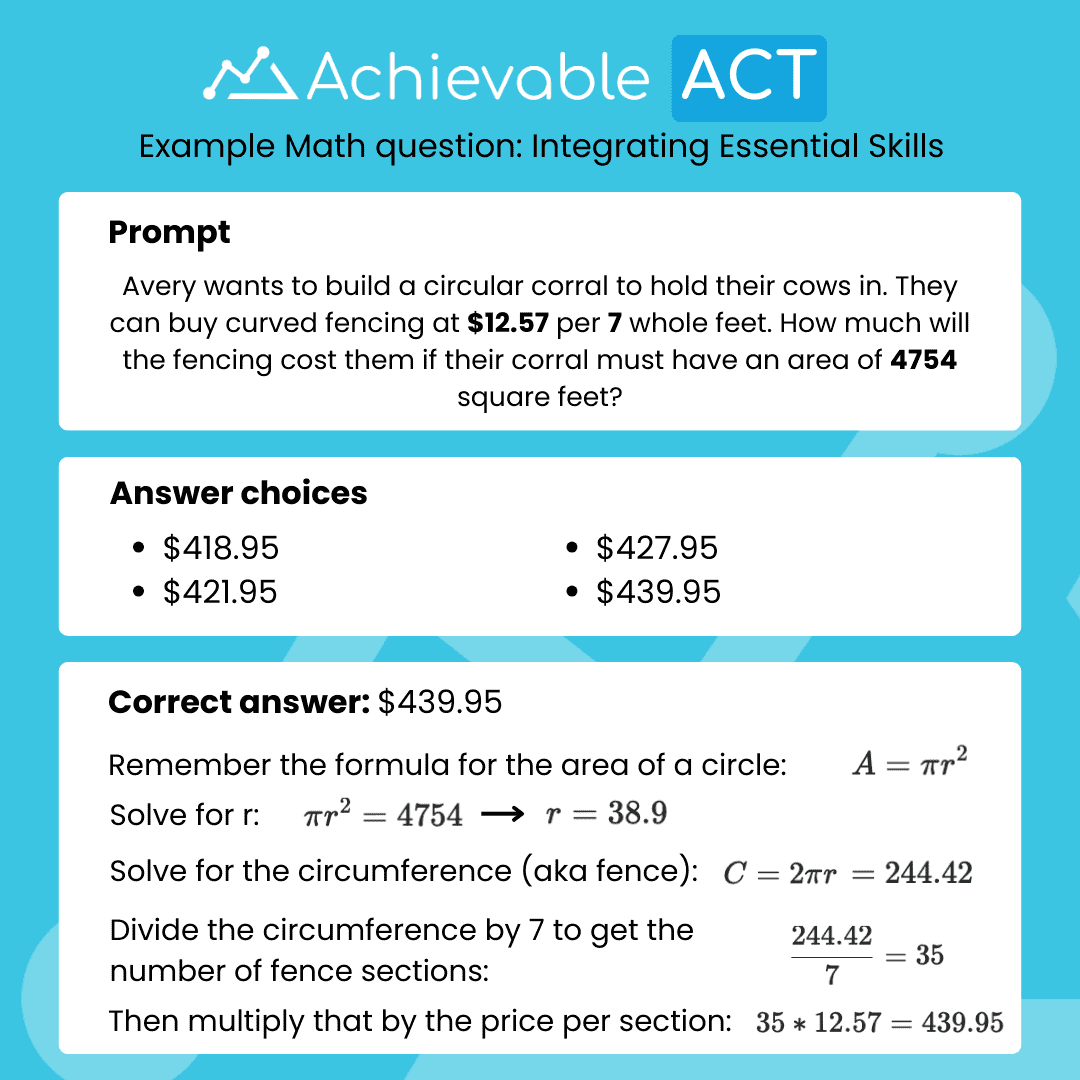
Integrating Essential Skills example question
Modeling (present throughout the ACT Math section)
Modeling is a weird category, because it is sort of behind the scenes throughout the ACT Math section. Modeling is the interpretation and manipulation of numbers in models – and models are “an abstract description of a concrete system using mathematical concepts and language.” Basically, what this means is that you’re going to be dealing with modeling any time you’ve got a question about how fast two trains are going, how much water it will take to fill a pool, et cetera. You’ve seen all of these before in your schoolwork, it’s just important to recognize that the key challenge with these wordy problems is figuring out what the math problem actually is.
The Integrating Essential Skills example question above also serves as a good example of how modeling comes into play on the ACT Math section.
How to beat the ACT Math section
Practice makes perfect. Math is a field where practice can make a big difference, and the ACT Math section is no exception. Make sure you are practicing the ACT Math questions that you’re getting wrong, and go back into your reading material to review where your mistakes are coming from. You should also tailor your practice to how frequently the question types appear:
Additionally, the ACT Math section is commonly one where students run out of time to properly answer all questions. This is intentional – the test gets harder and harder as you get from question 1 to question 60 – and it means that smart time management is crucial. Use problem solving procedures like annotations and crossing out wrong answer choices to move quickly through the first 40 questions of the section. Then, you will hopefully have more time to have a good shot at the last 20 difficult questions. And make sure you guess on any unanswered questions as the time is almost up – better to have a 25% chance of a correct answer than zero.
Lastly, make sure you review ACT’s calculator policy and get some practice in with your ACT calculator beforehand. It will likely not be the same one you use in school, and figuring out calculator functionality on test day is a waste of your valuable time.
The ACT Reading section tests you on your ability to read high school level English passages, determine the main ideas and arguments of those passages, infer what the author’s argument is, identify the significant details and evidence, and come to logical conclusions about the content. The ACT Reading section contains 40 questions on four passages, and you have 35 minutes to complete them. This gives you 8 minutes and 45 seconds per passage, or 52 seconds per question.
The four types of ACT Reading passages are:
Now that we’ve covered the passages, let’s talk about the question types. Each passage will likely contain questions from multiple or all of the question types.
ACT Reading question type | % of test | # of questions |
|---|---|---|
Key ideas and details | 52 - 60% | 21 - 24 |
Craft and structure | 25 - 30% | 10 - 12 |
Integration of knowledge and ideas | 13 - 23% | 5 - 9 |
Total | 100% | 40 |
Here are the three types of ACT Reading questions you will see on the exam:
Key ideas and details (52-60% of the ACT Reading section)
Key ideas and details questions ask you to read passages and understand their core ideas, themes, evidence, and arguments. In key ideas questions, you will need to be able to correctly identify what the author is arguing and understand the relationships between different points of the passage to draw conclusions about the arguments. In details questions, you will have to look through the passage to find the detail that the question is asking about.
Note that for most of these examples, we opted not to share the passage itself or answers. Instead, look at these examples as a guide for what these questions will look like.
Prompt: The main purpose of the passage is to:
Choices:
Explain why Holmes’s musical tastes gradually change over time
Describe how Holmes’s hectic professional life affects his personal life
Highlight the different instruments Holmes mastered in becoming a famous musician
Document how Holmes eventually became an enterprising bandleader
Notice how it’s asking for a high level answer here. This question is a good example of why it’s good to skim the questions beforehand so that you know what you’re going to be asked about later. When answering this question, you’ll want to also skim the passage again if you’re not 100% sure to make sure you’ve got the right answer for the specific question that is being asked: in this case, the main purpose of the passage.
Prompt: Based on the passage, the main reason Holmes eventually preferred playing music at weddings and private parties to playing music in clubs was that:
Choices:
He could play a wider variety of music at weddings and private parties
Audiences at weddings and private parties were easier to please
Weddings and private parties were more profitable
Weddings and private parties requires less travel
Unlike key ideas questions, details questions are very specific and focused on a single fact or inference that you can make from the passage. Oftentimes, the words used in the article are not exactly the same as the ones used in the answer choices, so you’ll need to carefully read the section of the passage related to the answer.
Details questions frequently use language like “the passage indicates”, “the narrator claims”, “according to the passage”, or “the passage states” – when you see these kind of lead ins, you should expect a details question.
Craft and structure (25-30% of the ACT Reading section)
Craft and structure questions test your ability to determine the meaning of words or phrases, understand word choice, and interpret the author’s and character’s points of view. You will need to be able to understand vocabulary in context, determine the meaning that the author was trying to convey, and understand why the author made that choice.
Craft and structure example question
Prompt: “His attitude about how people treated their pianos seemed to mirror his philosophy of life. While regretting the depredations worked by children on keyboard and strings, he regarded them as tolerable because the piano was at least used and, as he put it, “at the heart of the family.” It was more than just any piece of furniture, but it was that, too, and if drinks were spilled and stains bit into shiny finishes, it was the price one paid for initiating the young to a joy that should stem from familiarity rather than reverence.”
As it is used, the phrase bit into most nearly means:
Choices:
Pinched
Ingested
Marred
Severed
Answer: C. Marred. Answering craft and structure questions requires understanding the vocabulary word’s many definitions and also using the context to determine which definition the author was going for. In this example, “bit into” references the shiny finishes, which had drinks spilled and stains on them. This means that the shiny finishes were damaged by the spills and stains. In that context, marred is the only vocabulary word that matches the mention of physical appearance.
Source: Official ACT Practice Test 2176CPRE
Integration of knowledge and ideas (13-23% of the ACT Reading section)
Integration of knowledge and ideas questions test your ability to understand what an author is claiming, how the author’s argument is constructed, separate facts from the author’s opinion, and use evidence to determine what is right. You will need to be able to think critically about the passage and deduce the best answer logically.
Integration of knowledge and ideas example question
Prompt: Based on the passage, the residents of Gordon Heights in the 1950s and 1960s would best be described as:
Choices:
Artistic and sophisticated
Driven and optimistic
Friendly and easygoing
Generous and dependable
Unlike details questions, the answer to this question type is not in the passage itself. Instead, you will need to deduce the best answer based on the passage. Look for the relevant lines in the passage that are related to the answer, and keep in mind that these lines are typically spread out throughout the passage. Additionally, always look for some sort of evidence that backs up the answer choice in the passage, even if it’s only somewhat similar to the answer choices.
How to beat the ACT Reading section
Beating the ACT Reading section isn’t about memorizing vocabulary or grammar rules. Instead, it’s about approach, specifically annotations, time management and avoiding test traps.
Annotations
Annotations are crucial to beating the ACT Reading section. While it may seem simple, good annotations can speed up your reading and question answering, and also ensure that you’re focusing on the right things.
To annotate effectively, circle or put brackets around key information, like names, dates, locations, points that the author is making, or other “relevant information”. What is relevant will vary by passage type: in literary narrative passages, the perceptions, observations, feelings, and thoughts of characters are important; but in natural science passages, what the author is trying to prove and related evidence are important.
You can also annotate questions or parts of the passage directly related to a question. For instance, in the Craft and structure example question, the words “drinks spilled”, “stains”, and “shiny finishes” were all crucial for answering the question.
Time management
Time management is important to practice – many students don’t finish the ACT Reading section on their first attempt. You’ll recall that we said you had 8 minutes and 45 seconds to complete each of the four passages and their associated questions. When you break that down, the recommended time you should spend is about 3 minutes and 45 seconds to read the passage, and 30 seconds to answer each question. You should avoid reading the same material twice, and instead try your best to answer the question based on your annotations and, if necessary, a quick skim of the related material.
Some people choose to skip to the passages they are best at first. This can be a good way to make the most of your limited time, as all right or wrong answers count the same regardless of which passage they’re associated with.
Avoiding test traps
There are three test traps you want to avoid when taking the ACT Reading section:
If an answer choice copies language you’ve already read in the passage, it is more likely to be wrong. Just because it uses similar language doesn’t mean it answers the question.
Be very wary of extreme words like “always, never, best, worst”. These are absolutes that leave little room for nuance, which many questions take advantage of.
Beware of answer choices that have information that is irrelevant to the question. These are often leading you astray with unrelated information that sounds good, but isn’t the right answer.
The ACT Science section should be called the ACT Data Interpretation section, because it tests you on your ability to interpret and analyze data, come to conclusions about that data, and solve problems with said data. Questions on the ACT Science section will be related to the topics of biology, chemistry, Earth and space sciences, and physics. The ACT Science section does not require advanced science knowledge – all of the information you need to answer the questions will be presented to you, with the exception of some basic concepts learned in introductory classes for each discipline. The ACT Science section contains 40 questions on either six or (rarely) seven passages, and you have 35 minutes to complete them. This gives you 5 minutes and 50 seconds to complete each passage, or 52 seconds per question.
There are three types of passages in the ACT Science section:
Biology, Chemistry, Earth and space science, and Physics are all the fields of science that these passages could cover. Chemistry and biology are more likely to require equations and other details from their respective fields to answer questions, while Earth and space science and physics will rarely ask you to remember specific information related to the field.
ACT Science question type | % of test | # of questions |
|---|---|---|
Interpretation of data | 45 - 50% | 18 - 20 |
Scientific investigation | 20 - 30% | 8 - 12 |
Evaluation of models, inferences, and experimental results | 25 - 30% | 10 - 12 |
Total | 100% | 40 |
The three types of ACT Science questions you will see on the exam are:
Interpretation of data (40-50% of the ACT Science section)
Interpretation of data questions test your ability to sift through complex charts, graphs, and tables in order to get the data you need to answer the questions. You will be asked to understand what the question is asking for, find that information, and reason the correct answer based on that information.
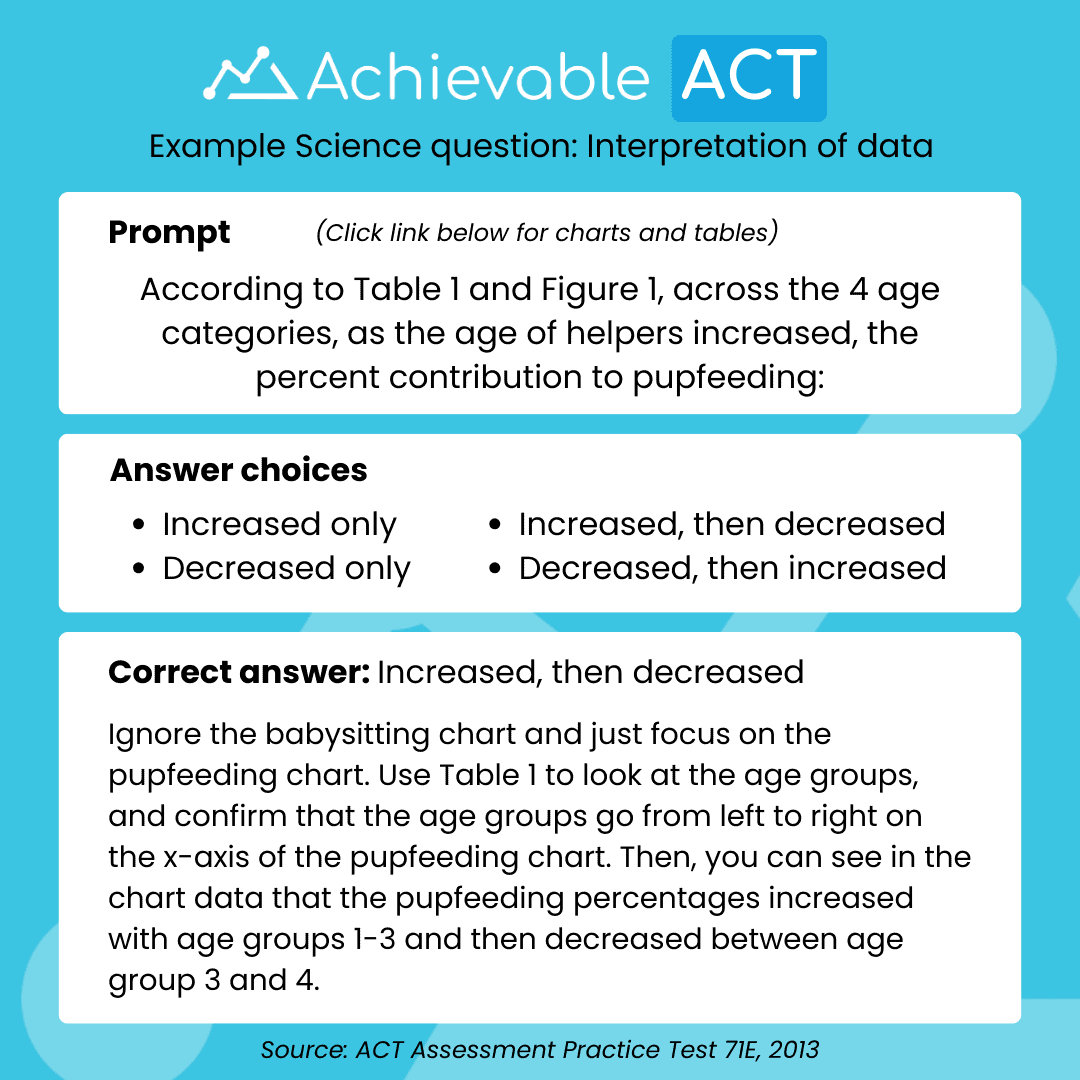
Interpretation of data example question
Source: ACT Assessment Practice Test 71E, 2013
Scientific investigation (20-30% of the ACT Science section)
Scientific investigation questions test your ability to understand experiment design such as controls and variables, and then compare, expand upon, or change those experiments. You will be asked to answer questions about how experiments are set up, what the results indicate, whether the hypothesis of the experiment is proven or disproven, and to predict the results of additional trials.
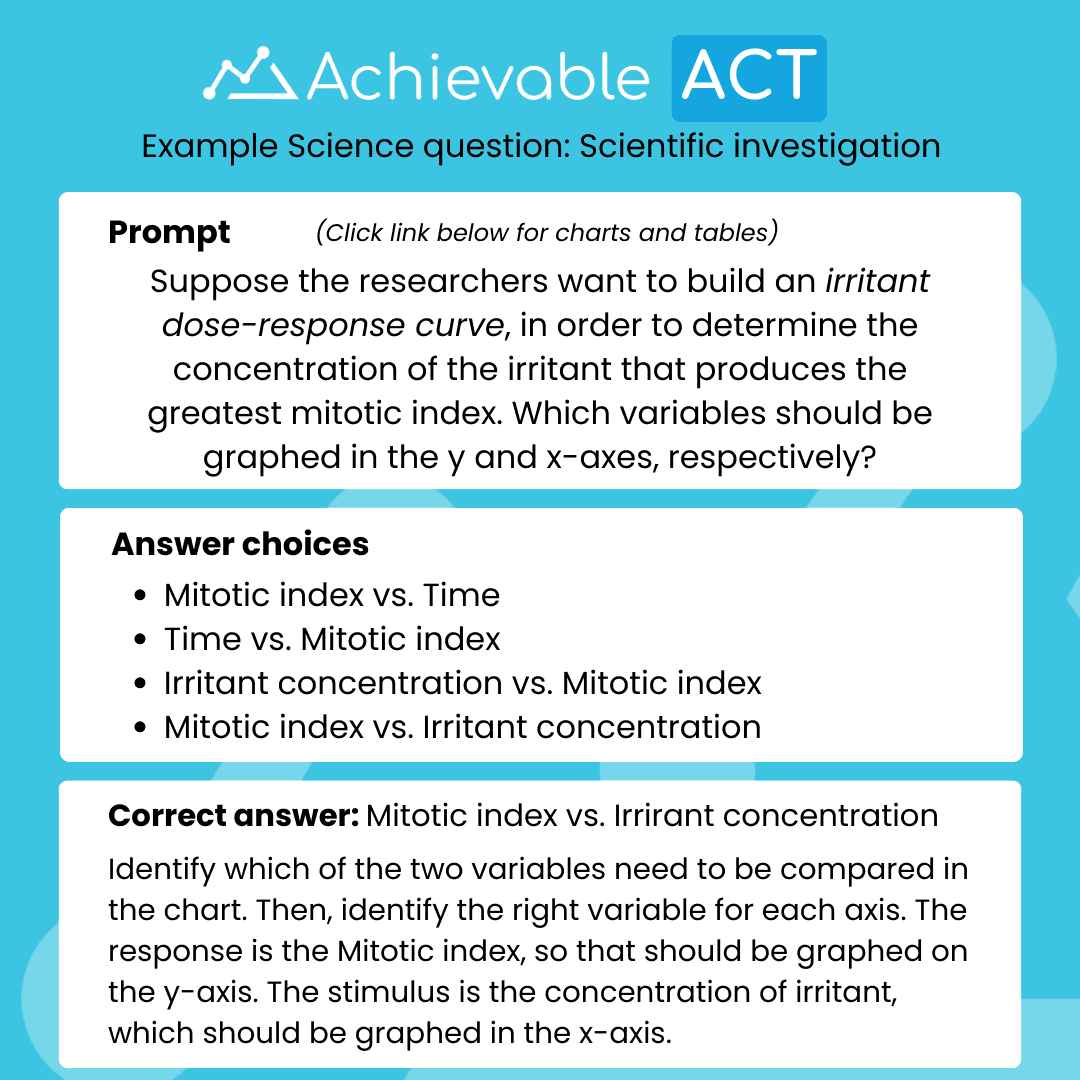
Scientific investigation example question
Evaluation of models, inferences, and experimental results (25-35% of the ACT Science section)
Evaluation of models, inferences, and experimental results questions test your ability to evaluate scientific information, question its validity, and draw conclusions based on that information. You will be asked to critically evaluate scientific experiments and their conclusions based on the data available.
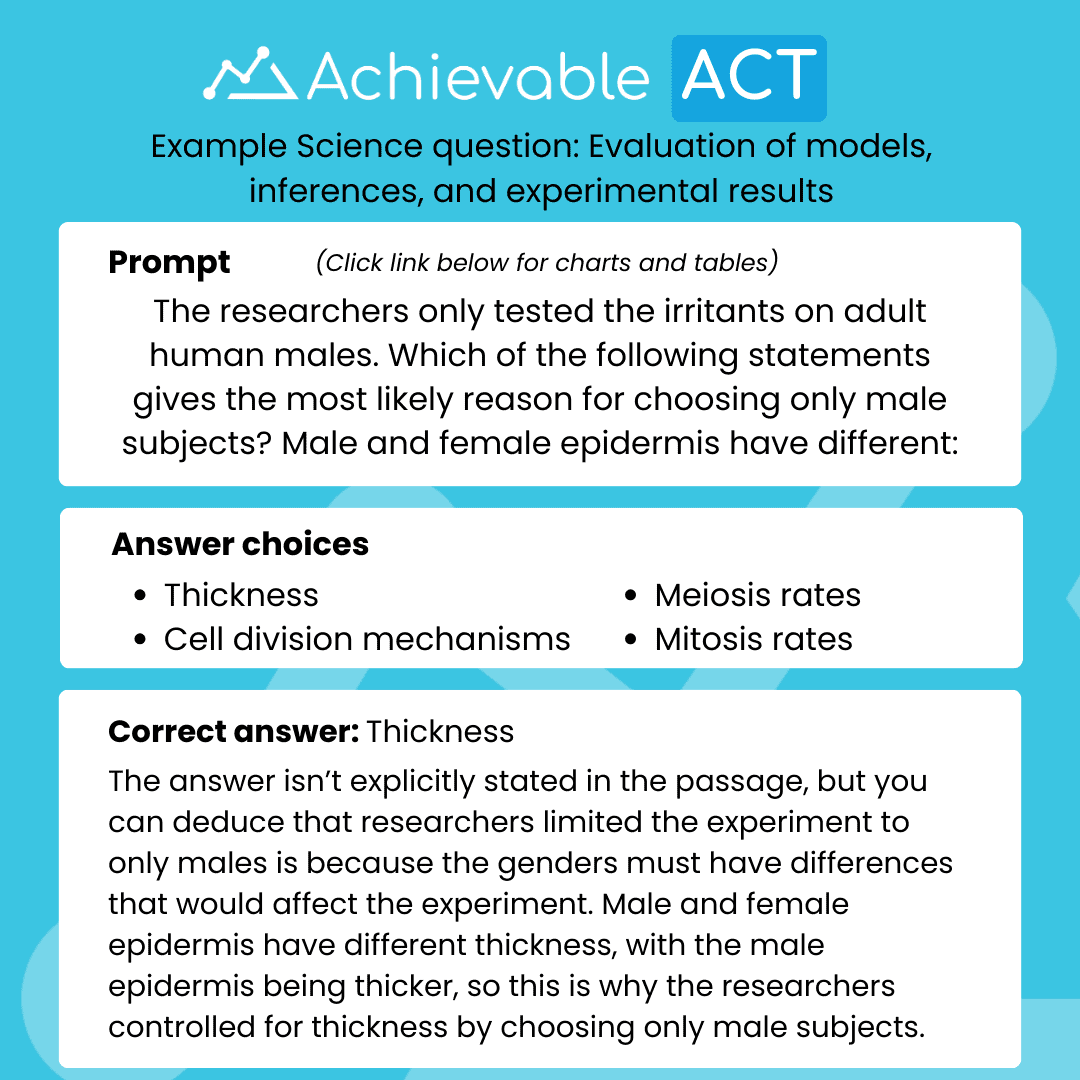
Evaluation of models, inferences, and experimental results example question
How to beat the ACT Science section
Don’t be intimidated by the science topics presented in this section – this is more like a data interpretation section than a science one and you’ll most likely be given everything you need to answer each question in the material provided. Think of it as a fact finding exercise – a treasure hunt, if you will – more than a science test. Here’s a few tips to help you beat the ACT Science section:
Pay attention to italicized words. These words are often central to the question, and they are not necessarily things you will know, so they will explain what it means immediately following the word in the question itself. Make sure you fully understand what the italicized word means or represents before answering the question.
Pay attention to the details. The details of charts, graphs, and tables will often have important context in them that may not be immediately obvious in other parts of the passage. For instance, the axes of a chart will help you figure out what relationship you’re viewing, while a legend in that same chart might tell you what is being compared.
Annotate questions. Like in the ACT Reading section, annotation can be a huge help in the ACT Science section. Circle or bracket key information in both the passage and the questions themselves to ensure you’re focusing on the right things.
Skip the passages. This is one of the best sections on the ACT for skipping right to the questions first. In fact, you may not even need to read the passage A-Z at all. Just go to the questions and answer each one, and by the end you’ll most likely understand the entire passage.
Use the answers to help you. If you’re unsure about what information the question is asking for, use the answers to help you figure out what to look for. If the answers are numbers, then figure out what those numbers represent in the data above. If the answers are comparative, figure out what the options are and then revisit the passage to see which fits best.

The optional ACT Writing section tests you on the writing skills that you learned in high school English classes, including your ability to write an essay with good structure and organization, use appropriate vocabulary and grammar, create and share ‘productive’ ideas, provide thoughtful perspective on the assigned topic, develop and support your perspective with evidence, and share the implications of your perspective.
While the ACT Writing section is optional, some universities do require students to submit a Writing Section score. Be sure to check if any of the schools that you are applying to require this.
The ACT Writing section contains one essay prompt and you have forty minutes to write an essay responding to the prompt. The prompt will contain a complex issue and three different perspectives on that issue.
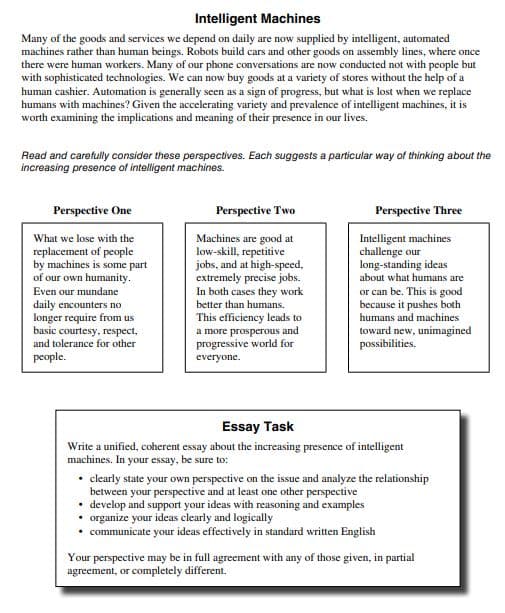
The ACT Writing section is graded on four writing domains from a 1-6 scale by two graders, for a final score of 2-12 in each domain. Then, your final score is the average of those four domai scores. The four domains are:
Ideas and Analysis – Your ability to ‘generate productive ideas’, think critically about the three different perspectives given about the issue, and respond with your own relevant thoughts on the issue.
Development and Support – Your ability to identify and effectively share the rationale behind ideas and arguments, including your own take on the issue.
Organization – Your ability to structure an essay in a way that is clearly organized and follows standard essay conventions. Includes properly showing the connection between ideas and guiding the reader through your thought process to your conclusion.
Language Use and Conventions – Your ability to write clear, effective arguments; and your ability to use correct and effective vocabulary and grammar.
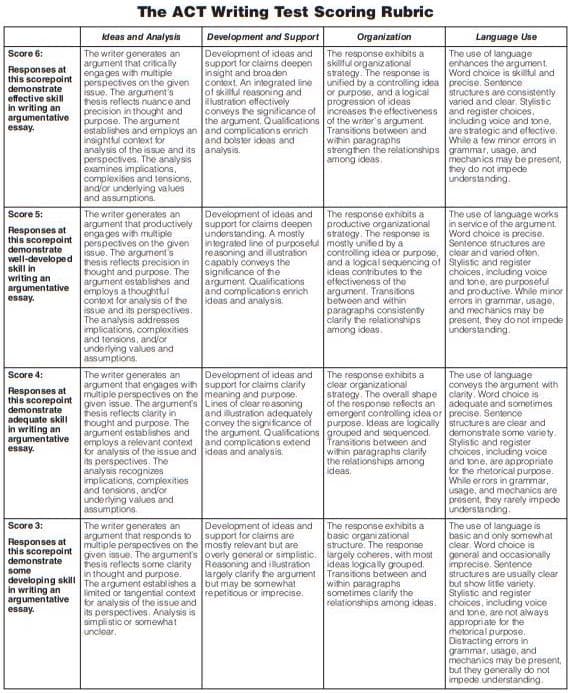
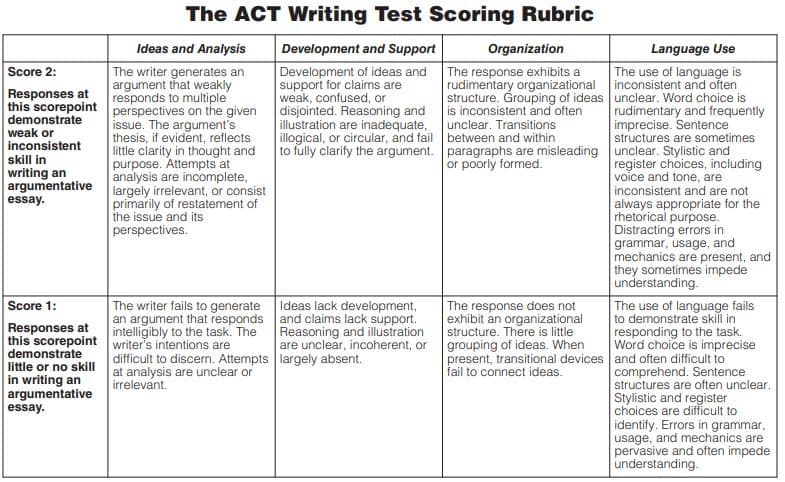
Insider tip: Getting a perfect 12 score on the ACT Writing section is extremely rare, so don’t fret if you don’t get a perfect score.
Recommended structure for your ACT Writing essay
You need to write an essay that nails all of the domains above while also being about a complex topic you’ve likely never seen before. To do this, it helps to have a plan, and having your essay structure in mind ahead of time makes writing the essay plug-and-play. We recommend the following structure for a powerful essay for the ACT Writing section:
Introduction – Grab your reader’s attention, establish the subject, and include key background information. End with a thesis statement.
Supporting paragraphs – At least three paragraphs with one focused topic each that support your thesis – with evidence for each point.
Counter argument – One paragraph that identifies an alternative perspective that others might agree with, and then why you refute that counter argument.
Conclusion – Restate your thesis and wrap up your argument concisely. Do not introduce any new arguments or evidence in the conclusion.
How to beat the ACT Writing section?
The key to beating the ACT Writing section is to write for your audience. Your audience, in this case, is a professional ACT reader. They are typically an education professional that has a degree in the humanities or social sciences, and doing this as a part time job in addition to another full time job. Because of this, there are a few tactics you can employ to make your writing more engaging:
Should I take the ACT Writing section?
Obviously if a college that you are applying to requires the ACT Writing section, you should take it. However, if none of them do, then you have a choice.
The upside of taking the ACT Writing section lies in whether you are a strong writer, and whether writing is relevant to your major. If the ACT Writing section is truly optional for you, and you struggle with writing, it is better not to take it and focus on improving your ACT English and Reading scores. If you are a good writer, then it could be beneficial to submit a strong ACT Writing score if you are applying for an English, Writing, or Humanities major. And finally, if you are applying to a very competitive college, a good ACT Writing score can only help.
The ACT is 2 hours and 55 minutes of test time. Including breaks, the full exam takes about 3 hours and 30 minutes total. If you opt to do the ACT Writing section, then the test becomes a total of 3 hours and 40 minutes, or a little over 4 hours when you include breaks.
Section | # of questions | Time | Time per question |
|---|---|---|---|
English | 75 | 45 minutes | 36 seconds |
Math | 60 | 60 minutes | 60 seconds |
Reading | 40 | 35 minutes | 52.5 seconds |
Science | 40 | 35 minutes | 52.5 seconds |
Writing (optional) | 1 | 40 minutes | 40 minutes |
Total (without Writing) | 215 | 175 minutes | 49 seconds |
The ACT costs $68 for basic registration with no ACT Writing section. This includes score reports for you, your high school, and up to four colleges. If you’d like to add the ACT Writing section, then the ACT costs $93 and includes the same reports.
There are additional fees for actions that you can take regarding administration of the test:
If you ‘meet one or more of the indicators of economic need’ according to the ACT, you may be eligible for ACT’s Fee Waiver Program. Visit their website to see if you qualify.
The ACT is a college admissions test, so it is meant to measure your readiness for college courses. It is designed to challenge high school juniors and seniors on a typical academic path, without testing you on things that you do not know. It is similar in difficulty to the SAT, the other popular standardized college admissions test. Let’s explore what makes the ACT hard and provide comparison between the ACT and SAT along the way.
Time constraint
The primary thing that makes the ACT hard, and harder for some students than the SAT, is the time constraint. The ACT totals 175 minutes and 215 questions, so you will need to answer most questions in under a minute, and in some sections even less. This is challenging for students that are slower paced, and can sometimes lead to increased test anxiety and mistakes. To address this, you should prioritize earlier questions in each section, which are easier, and include time limits in your practice so you get used to the pace of the exam.
Lack of math formulas
The ACT does not provide the key math formulas you need to solve the problems in the ACT Math section. This means it is up to you to memorize and know how to apply these formulas.
Advanced math
The ACT contains more advanced math (specifically algebra II and trigonometry) than the SAT, though it is in small quantities and only present in the harder questions on the ACT.
Long passages
The ACT Reading and English sections both contain long passages that you must read and then answer multiple questions about. This is in contrast to the new digital SAT, which only uses short passages with one question per passage. If you are not a fast reader or English is not your first language, these long passages can make the ACT more difficult.
Science section
The ACT Science section is unique to the ACT. While the section does not require specific scientific knowledge, it does require you to be able to understand charts, graphs, experiments, and other data – and draw conclusions from that data. This can be challenging for students that struggle with data or applied math.
All in all, the ACT is similar in difficulty to the SAT, but has some differences that can be challenging for certain test takers.
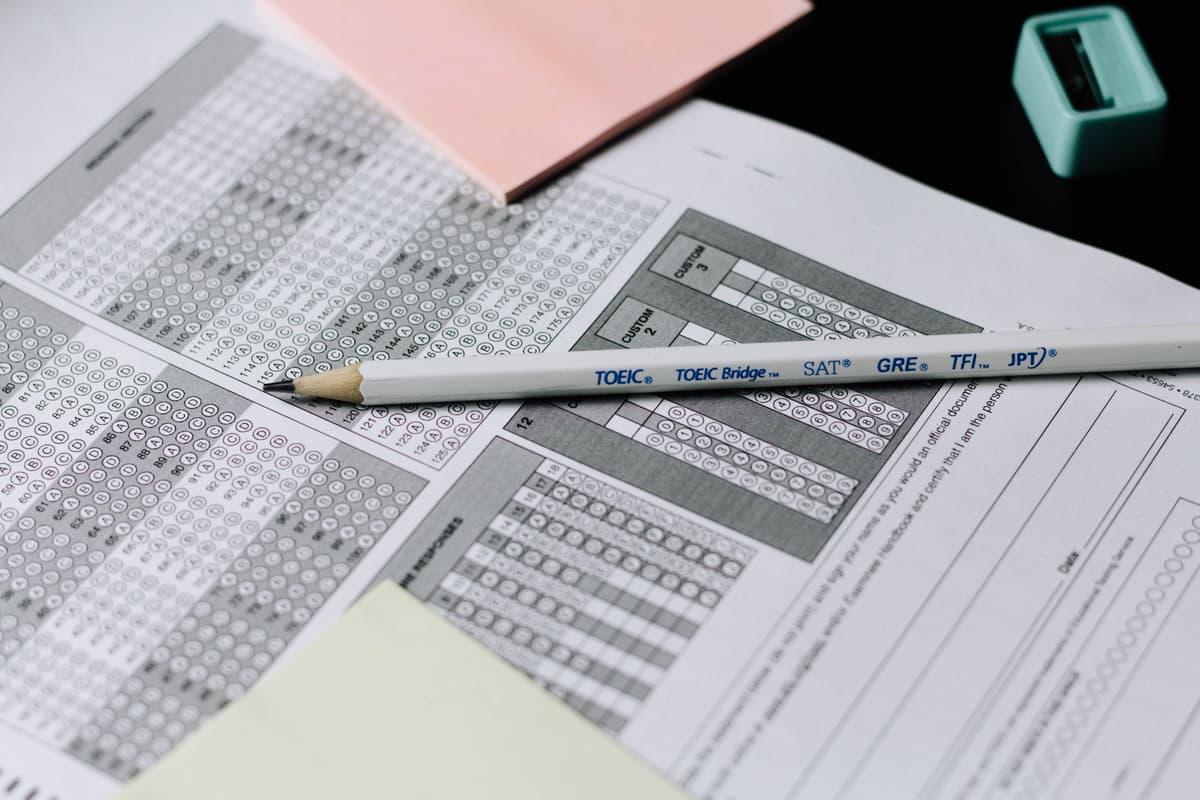
Your ACT score is actually two scores. First, you have your raw score, which is simply how many problems you got right out of the possible total. Then, that raw score is converted to a “scale score” by ACT, which is what you and the colleges you submit the score to see.
Think of this as grading on a curve. Your raw score is how many problems you got right or wrong. Each test is a little different, so after collecting data about the test, the ACT converts this to a scaled score based on their calculated difficulty of the exam and the number of questions that other test takers got on that section.
Your scaled score for each section is a minimum of 1 and a maximum of 36, with 36 being the best. Then, your four section scores (each between 1 and 36) are averaged to create your Composite score. Colleges see both your individual section scores and the Composite score.
If you take the ACT more than once, you may be able to take advantage of “super scoring”. Some colleges will let you submit your best ACT section score from each section, regardless of whether they happened on the same test day. For instance, if:
Super scoring gives you the ability to employ a useful prioritization strategy: between tests, focus on your weak score areas and upkeep but not focus on the areas you scored well in. In the example above, if you scored a 35 on the ACT Math in September, then you know you’re probably good in that section, and can focus on improving your weakest scoring categories.
The best way to gauge a good ACT score is by comparing your score to the ACT scores of other students applying to your target universities. This data is often available on the university website, in the US News & World Report Rankings of the best colleges, or through a Google search (try “University name ACT score average”). In general, you want ACT scores above the average of your target school if you want to improve your chances of getting in through your test scores. However, do keep in mind that half of students are admitted with below average scores (that’s how averages work after all), so don’t fret if you’re not hitting your goals. There are many aspects of a college application that factor into admissions decisions, including your background, extracurriculars, capstone project, essay, and references.
In addition to looking at average scores, you should look for data about your target school’s ACT percentiles. A percentile is essentially “what percentage of total applicants that the score beats”. So a score that is 90th percentile is better than 90% of all ACT test takers applying to that school. In general, it is very hard to get into a college when your score is below the 25th percentile (in the bottom 25% of scores), and a score above the 75th percentile (in the top 25% of scores) will improve your admissions chances.
To give you some guidance, below are the percentile scores for the ACT averaged across the entire US:
Scaled score | English percentile | Math percentile | Reading percentile | Science percentile | Composite percentile |
|---|---|---|---|---|---|
36 | 100 | 100 | 100 | 100 | 100 |
35 | 99 | 99 | 98 | 99 | 99 |
34 | 97 | 99 | 96 | 99 | 99 |
33 | 95 | 98 | 94 | 97 | 98 |
32 | 94 | 97 | 92 | 96 | 97 |
31 | 92 | 96 | 90 | 95 | 95 |
30 | 91 | 95 | 88 | 94 | 94 |
29 | 90 | 94 | 86 | 93 | 92 |
28 | 88 | 92 | 84 | 91 | 90 |
27 | 87 | 90 | 81 | 89 | 87 |
26 | 85 | 87 | 79 | 87 | 85 |
25 | 82 | 83 | 76 | 84 | 81 |
24 | 79 | 79 | 74 | 80 | 78 |
23 | 75 | 75 | 69 | 74 | 74 |
22 | 71 | 71 | 64 | 67 | 69 |
21 | 66 | 68 | 59 | 62 | 64 |
20 | 60 | 65 | 53 | 56 | 59 |
19 | 55 | 61 | 48 | 50 | 53 |
18 | 51 | 56 | 43 | 44 | 47 |
Mean | 19.0 | 19.4 | 20.5 | 20.0 | 19.9 |
Source: ACT, Inc. | |||||

The ACT is offered on designated national test dates at high school and local school campuses in February, April, June, July, September, October, and December. For specific dates, see our post about ACT test dates, or you can review the key information below:
Year | Test Date | Deadlines |
|---|---|---|
Registration | Late Registration | Standby & Photo |
2024 | September 14 | August 9 | August 25 | September 6 |
October 26 | September 20 | October 7 | October 18 |
December 14 | November 8 | November 22 | December 6 |
2025 | February 8 | January 3 | January 20 | January 31 |
April 5 | February 28 | March 16 | March 28 |
June 14 | May 9 | May 26 | June 6 |
July 12 | June 6 | June 20 | July 4 |
Remember, if you miss the late registration deadline, you can request standby testing. This gives you the opportunity to take the test on that date so long as there are seats available. Your testing fee will be refunded if you do not get seated.
Many students will start their studying in the summer, which lines up well with the September ACT test date. Then you have another month to prepare to retake it in October, or three months to prepare to retake it in December. This is the typical schedule, but there are also many students that have summer jobs or other commitments, so they may opt to take the ACT on another schedule.
Scores are sent out two weeks after each national test date, but it can sometimes take up to eight weeks. Therefore, you should schedule your test for at least two weeks before the score deadline for your target universities. If your score is already available and you request an additional score report, that report is often sent within one business day.
How long to study for the ACT? A general guideline is that you should study for at least 2-3 months. As we mentioned before, dedicating a summer to ACT prep is generally a good idea if you’re targeting the September test date. You should expect to spend at least 100 hours studying, which over 8 weeks (2 months) is 12 hours per week, or over 12 weeks (3 months) is 8 hours per week. Be sure to schedule this study time in advance to ensure you leave space for it!
Naturally, the more you want to increase your score, the more that you should expect to need to study. If you want to improve your ACT score by 10 points or more, then six months of dedicated studying is recommended.
The ACT tests you on what you learned in high school math, English, and science classes, so your first order of business is to make sure you have learned all of the prominent concepts in each of these classes. Oftentimes, you will need to go back and revisit your notes or old books to ensure that you remember things like the Pythagorean triples or other important formulas. Revisiting this material can also help you with studying down the road as you organize your notes. Then, once you’ve got that down, it’s time to move on to true ACT preparation.
There are many ways to prepare for the ACT, but at a high level, there are four main paths (ordered from least to most expensive):
In all of the above options, the quality of your ACT preparation materials is going to vary depending on the instructor you get or the course you purchase. For online courses, the quality of the software also makes a big impact.
One economical approach that we recommend is to start with an online self-study course, and then hire a tutor to target weak areas. A good online self-study course should point out your weak areas and give you practice problems that you can bring to a tutor, teacher, or parent for review. And if cost is no object, then going with a tutor from the beginning will be your most personalized and hands-on option.

The easiest way to register for the ACT is to do so online. To do so, go to the ACT website, then click “Sign In” at the upper right portion, then click “MyACT Sign In”.
Once on that page, select “Create MyACT Account”. It will then ask you to choose from two options: “I registered or tested before” or “I’m new! Let’s get started”. Choose the option that’s applicable to you and fill out the fields with all the required information.
Be sure to enter your name exactly how it appears on your acceptable ID. Test administrators will check if your account name matches that on your ID on test day, and if it doesn’t match, even if it’s close, you won’t be permitted to take the exam.
After you’ve provided your information, verify your registration via email or SMS. Do this final step to finish the account creation process.
Having a MyACT account gives you functionality related to your scores and test registration. These include checking your scores online, making necessary adjustments to your registration details, and requesting score reports. These are just some privileges that you otherwise might not have if you don’t have a MyACT account.
After you’ve created your account and confirmed that all of your information is accurate, it’s time to register for your test date. Click the “Register” button and answer the following questions:
Once you’re done with these questions, you will then be asked to upload a current headshot. ACT test administrators will use this headshot and your ID to ensure that you’re the person taking the test in your own name.
Once that’s done, you’ll be asked to pay for your ACT test. After doing so, you’ll receive your voucher number which you then plug into the voucher number field. Click “Submit” to finalize the registration. Then, make sure to print out your registration ticket – you will need this at the test center on test day.
All US students must take the ACT test offline in a testing center by default. Only international students or students with special accommodations can take the ACT test online. Here’s a quick breakdown:
Type of Student | ACT Modality |
|---|---|
U.S. student taking the ACT on a national test date | Paper only |
International student | Computer-based only |
U.S. student taking the ACT on a school-day test date | Will vary depending on which district/state their school is located |
No matter whether you take the ACT online or offline, the exam structure will be the same.
The ACT offers special testing accommodations to anyone covered by the standard definitions of disability in the Americans with Disabilities Act.
To start requesting special testing accommodations, indicate a need for these when registering for the ACT. After registering, you will receive an email from ACT containing instructions on how to submit a request for accommodations in ACT’s Test Accessibility and Accommodations System (TAA) with the assistance of a school official.
Most people can easily get special testing accommodations with a corresponding IEP or 504 Plan. In the absence of such plans, you will need to submit proof of the limitation that would warrant special assistance during the test. Refer to ACT’s Criteria for Diagnostic Documentation and Documentation by Type of Disability for more details on qualifications, or take a look at ACT’s policies for requesting accommodations here.
On test day, you should bring the following items:
Do not bring cell phones, non-permitted calculators, or any other prohibited items – doing so will likely result in you being turned away and not being allowed to take the test. It goes without saying, but don’t break anything that could potentially be used to cheat like your notes into the test area.
Make sure to arrive early – you do not want to be rushed and add that stress to your already-stressful test experience. The venue opens at 7:45am, and closes at 8:00am – you should schedule to arrive between 7:30am and 7:45am. Also, if the test is in an unfamiliar location, be sure to go there once before test day so you know how to get there and where to go.

ACT scores take at least 2 weeks to be released to you, your high school, and your target schools. They warn that in some circumstances, it could take up to eight weeks.
ACT scores never expire. This means that if you take a gap year or enter the workforce, your scores will still be there when you get back.
You can select up to four colleges to receive your ACT scores when registering for the exam, and the ACT will send those scores for free. You can add a fifth and sixth score submission for an extra $18.50, and then every additional score submission after that costs an additional $18.50. You can do this before the exam when registering, or after the exam via the ACT website by logging into your MyACT account and clicking the “Send Your Scores” link. Follow the instructions there to send your scores.
If you signed up institutions to receive your scores when registering, then they will get your scores at the same time as you do – about 2 to 8 weeks after the test day. If you have already received your scores and ask for them to be submitted to institutions, they should receive them within 1-2 business days.
You can take the ACT up to 12 times total. Most students take the ACT between 2 and 4 times, so if you didn’t get the score you wanted the first time, it’s normal to try again!

Looking for the average ACT scores by state and the percentage of graduates that took the ACT? Then look no further! In this deep dive, we review four years of data to get insight into which states are doing the best – and worst – with the ACT exam.

Hello! My name is Sophia Gatto, and I am a Marine Corps veteran. I recently wrote an in-depth guide on everything you need to know about the ASVAB. Passing the ASVAB is the essential first step toward starting your military career. Preparing for the ASVAB is crucial, as it not only determines which branches you …

We’ve tracked down the acceptance rates of some of the easiest colleges to apply for in the country, so you don’t have to. With special sections for CA, FL, TX, and NY. Read on to find out more.